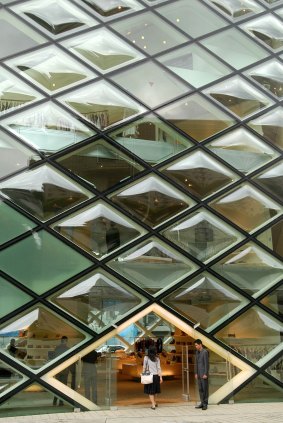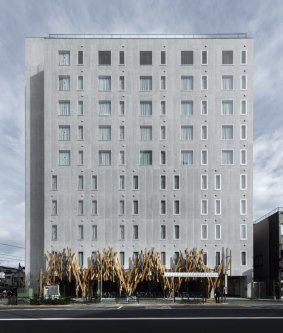This was published 4 years ago
Tokyo architecture: Tour the city's cutting-edge buildings
By Louise Southerden

The bubble-sided Prada "Epicentre" designed by Swiss architects Herzog & de Meuron.Credit: AAP
It's not every day you get to sleep in a landmark that's on your tour itinerary. But ONE@Tokyo, where I'm staying, was designed by Kengo Kuma, one of Japan's best-known architects, making it the perfect starting point for an architectural walking tour of Tokyo. The hotel's forest-like wooden facade also brings nature to the city, a theme my InsideJapan guide, British expat Mark Rawlins, says we'll be seeing a lot more of on this private all-day experience.
Mark's not an architect, but InsideJapan's guides are so well-rounded – he has a degree in law and politics, reads Russian literature and has lived in Tokyo for five of the seven years he's been in Japan – you can pull almost any subject out of a hat and they'll design a tour around it.
I've chosen contemporary architecture, having long been a fan of Japanese design. As we plan the day over coffee near my hotel, Mark confesses that he used to think of Tokyo as a "big, ugly metropolis" – until an American architect friend helped him appreciate the uniqueness of Tokyo's built environment.

ONE@Tokyo is the perfect starting point for an architectural walking tour of the city.
"Tokyo's buildings don't seem to have the permanence of those in other cities," says Mark. That's partly circumstantial: the city was almost completely rebuilt after the Great Kanto earthquake in 1923 and again after extensive bombing during World War II. But it's also an attitude.
"When I think of London, I think of buildings built to last forever," he explains. "When I think of Tokyo, I think of something popping up and being pulled down in a few decades."
Whatever the reason, it means Tokyo's architecture is always on the cutting edge, which is what makes it so exciting. It's a life-sized showroom for Japan's – and some of the world's – most innovative architects. "The whole of Tokyo is a who's who of architecture," Mark says.
It's my first visit to Tokyo in 20 years and I'm surprised how easy, and inexpensive, it is to get around by subway, all the lines colour-coded and the stops numbered. It helps that InsideJapan has provided me with a prepaid travel card and Mark covers all our expenses for the day such as meals and entry fees.
This is luxury, in day-trip form: wandering the city with a local, having the freedom to just look and learn, and never having to look at a map.
Our first architectural stop looks like a cruise ship that's run aground, or a monster transformer. Edo Tokyo Museum was ahead of its time when it opened in 1993; today it's a Brutalist monument to its architect, Kenzo Tange, who won the Pritzker Prize for the stadium he designed for the 1964 Tokyo Olympics and is often called "the father of modern Tokyo".
Continuing on, we come to a very different-looking museum: a windowless silver monolith rising from an otherwise ordinary residential street. It's the Sumida Hokusai Museum, which opened in 2016 and was designed by another Pritzker-winning architect, Kazuyo Sejima.
"Tokyo has lots of unique buildings like this, dropped in random parts of the city," Mark says.
Inside, daylight streams in from unexpected angles, through shard-shaped lightwells, the all-white interior and high ceilings creating a canvas for the legendary artist's woodblock prints of great waves and Fuji views.
As we walk, we talk about impressive buildings in other parts of the city, a couple of which I'd stumbled upon the previous day in Aoyama, the Toorak of Tokyo: the bubble-sided Prada "Epicentre" designed by Swiss architects Herzog & de Meuron; and the SunnyHills pineapple cake shop designed for the Taiwanese brand by Kengo Kuma, his trademark use of wood making it resemble a giant basket.
Occasionally we stray off the architectural trail to see cherry trees in full bloom at Ueno Park, visit a famous shrine or chat about Japanese politics and how the city is preparing for next year's Olympics.
When we emerge from our last subway stop at Ginza, Tokyo's glimmering, glamorous shopping district, I appreciate another advantage of having a guide: Mark has timed things perfectly. We're there right on dusk, when many of the buildings, lit from inside, come to life.
We take a name-dropping stroll along Ginza's gingko tree-lined streets, ticking off luxury brands – Armani, Burberry, Cartier, DeBeers – and stopping to stare up at buildings that seem to play by their own rules. There's the pearl-pink Mikimoto building by Toyo Ito with its odd-shaped windows revealing structural features. The curvaceous De Beers building by Jun Mitsui, which slouches stylishly between its more conservative neighbours. Another Kengo Kuma: Tiffany & Co, its jewel-like facade of glass and aluminium honeycomb designed to diffuse light like a cut diamond. And the skin-coloured Louis Vuitton store, by Aoki Jun, whose walls mimic the brand's distinctive checkerboard pattern.
As we reach the Nissan Crossing, aka Tokyo's Times Square, the Seiko clock tower atop the neoclassical Wako building strikes 5pm and the streets are suddenly abuzz with commuters – and consumers. A crowd forms around Nissan's latest sports car, red of course, which twirls on a dais at street level. Directly above, Ginza Place, housing the global flagship store for Sony as well as Nissan, is more impressive: an 11-storey optical illusion designed by Tokyo-based Klein Dytham Architecture, its white aluminium-panelled sides creating curves out of straight lines.
Around the corner, we pop into the narrow, glass-walled Itoya building, Japan's most famous stationery store, where the 12 themed floors of colourful cards, notebooks, writing paper, travel gear and pens are packed with shoppers. "Consumerism is god in Ginza," says Mark.
Ginza isn't all new and gleaming. Sneaking down a side street, we find the modest brown-brick Okuno Building. It looks like a senior citizen among supermodels, but what it lacks in glitz it makes up for with old-school charm. Built in 1932 as a modernist apartment complex, it's one of the oldest buildings in Tokyo, having survived both World War II and the 1980s building boom, to become a rabbit warren of quirky art galleries and antique shops.
Our last stop is Hermes' Japanese headquarters. Designed by Renzo Piano, it's made of more than 13,000 glass bricks; as night falls, we see it glowing from within like a creature from the deep.
It's one more example of nature working its way into urban design, along with a certain ephemeral quality – two themes that trace their roots back to the Metabolism movement initiated by a group of Japanese architects in the 1960s, whose biological ethos still rules: that buildings and cities, like living organisms, like us, must keep growing and changing in response to their environments.
"It also ties in with Japan being used to weathering natural disasters," says Mark over a sushi dinner in a quiet Ginza lane. "It's a country that's used to things being there one minute and gone the next. You've got to admire that."
Back at ONE@Tokyo that evening I sit in the hotel's peaceful rooftop garden looking out at the sparkling, sprawling city I understand a little better now after seeing, up-close, a few of its brightest architectural stars.
TRIP NOTES
FLY
Qantas flies direct from Sydney to Tokyo Haneda daily and from Melbourne and Brisbane to Tokyo Narita daily. See qantas.com
TOUR
InsideJapan Tours can arrange private, bespoke Tokyo sightseeing days with their local experts as part of fully tailored travel packages that include everything from accommodation to prepaid transport cards. Call (07) 3186 8800 or see insidejapantours.com
STAY
The Kengo Kuma-designed ONE@Tokyo in Oshiage, north-east Tokyo, has studio rooms from ¥10,000 a person a night. See onetokyo.com/en/
MORE
Louise Southerden travelled as a guest of InsideJapan Tours and Tourism Shizuoka Japan.
Sign up for the Traveller newsletter
The latest travel news, tips and inspiration delivered to your inbox. Sign up now.